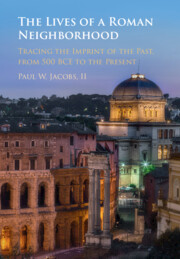Book contents
- The Lives of a Roman Neighborhood
- The Lives of a Roman Neighborhood
- Copyright page
- Dedication
- Contents
- Illustrations
- Acknowledgments
- Introduction
- One Remembering the Meadowlands
- Two Setting Out Lines
- Three Fit for an Emperor
- Four The Long Show Ends
- Five Repurposing Space in the Early Medieval Era, 554–ca. 1000
- Six Filling in the Blanks
- Seven Growth and Decline along a Commercial Corridor, ca. 1347–1555
- Eight Two Rioni in One
- Nine Old Walls Razed, New Walls Built
- Ten Travertine and Stolpersteine
- Epilogue
- References
- Index
- The Lives of a Roman Neighborhood
- The Lives of a Roman Neighborhood
- Copyright page
- Dedication
- Contents
- Illustrations
- Acknowledgments
- Introduction
- One Remembering the Meadowlands
- Two Setting Out Lines
- Three Fit for an Emperor
- Four The Long Show Ends
- Five Repurposing Space in the Early Medieval Era, 554–ca. 1000
- Six Filling in the Blanks
- Seven Growth and Decline along a Commercial Corridor, ca. 1347–1555
- Eight Two Rioni in One
- Nine Old Walls Razed, New Walls Built
- Ten Travertine and Stolpersteine
- Epilogue
- References
- Index
Summary
To the west of the Theater of Marcellus, efforts to erase a neighborhood were only partially successful. Buildings were removed but not the cultural identity of the space nor the subtle but discernible topographical imprint of its prior life. The Jewish community that first arrived from Trastevere a millennium ago simply moved aside when the circus plaza was swept clean and then slipped back to reclaim its long-held space.
- Type
- Chapter
- Information
- The Lives of a Roman NeighborhoodTracing the Imprint of the Past, from 500 BCE to the Present, pp. 222 - 224Publisher: Cambridge University PressPrint publication year: 2022

